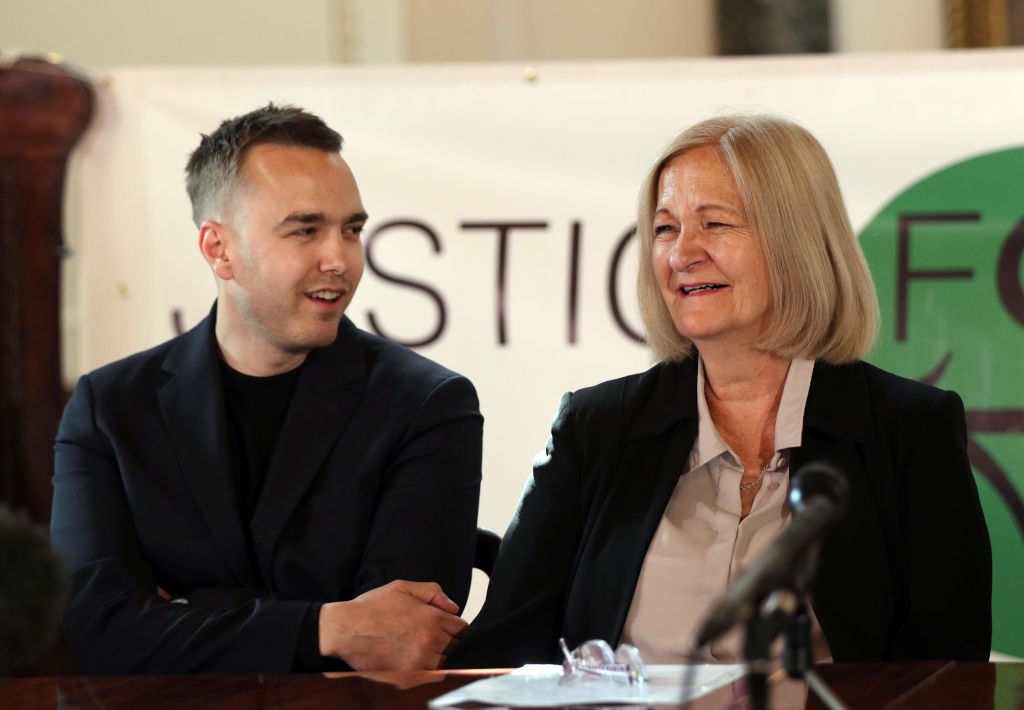
At first, it seemed sweet. Natalie Curtis’s boyfriend called her dozens of times a day, keen to hear every detail of what she was doing in her daily life: what she ate for lunch, who she saw at work.
But she says the longer she spent with him, and particularly after they married in 2016, four years after meeting, the more his behavior became intimidating. He made comments about what she ate. He picked fights when she went out with her friends. He threw her things around their house. He berated her while out shopping. One night, she says, he even threatened to kill her. “It’s such a drip effect, each event gets a bit worse and a bit worse,” Curtis says, speaking softly from her home in Essex, southeast England. “And then someone has control over you.”
“Coercive control” is the label domestic abuse experts give to the experience that Curtis, a 38-year-old safety specialist on the U.K.’s railways, endured. It encompasses a series of non-physical behaviors — including threats, humiliation, monitoring and isolation from friends and family — that they say can be just as damaging as physical violence, often causing severe depression and post-traumatic stress disorder. In 2015, England and Wales became the first nations in the world to criminalize such controlling behavior within relationships, making coercive control punishable by up to five years in jail. Women make up 95% of those who experience coercive control and 74% of perpetrators are men, according to a study by one U.K. police force.
Curtis began taking notes about the abuse, saving text messages, phone records and even filming her husband’s outbursts. She left him last June, and in October, he was sentenced to two years in prison after pleading guilty to a charge of coercive control. Her case marks an early victory for England and Wales’ legislation.
For decades, law enforcement agencies worldwide have seen domestic abuse almost exclusively in physical terms, measuring its severity in individual beatings and injuries. The 1994 federal Violence Against Women Act in the U.S., for example, criminalizes only “felony or misdemeanor crimes of violence” in domestic contexts.
In this corner of the world, though, policymakers are trying something new. Ireland and Scotland followed England and Wales with their own coercive control laws in January and April of this year. By criminalizing behaviors many previously considered merely unpleasant, domestic abuse advocates hope these laws will transform how society views acceptable power dynamics in relationships and how we tackle abuse. “We’re beginning to understand that it isn’t about one-off incidents. Abuse is a pattern, a war of attrition that wears a person down,” says Laura Richards, a British criminal behavioral analyst who helped pass the 2015 law after nearly two decades working in the domestic abuse sector. “Coercive control is the very heart of it.”

Nearly four years after the law came into force, coercive control is back in British headlines because of the case of Sally Challen. Challen, now 65, beat her husband to death with a hammer and was convicted of murder in 2011, spending the past eight years in prison. But on June 7 she walked free. Judges quashed the conviction on the grounds that Challen was suffering a psychological “adjustment disorder,” which the defense argued was the result of decades of coercive control by her husband. The prosecution accepted Challen’s new plea to the lesser charge of manslaughter, meaning she would be immediately released because she has already served more than the average manslaughter sentence.
Women’s rights activists see Challen’s case as a test of how seriously the English legal system takes coercive control – a relatively new concept for judges and legal professionals. Though judges who overturned Challen’s conviction in February emphasized that their decision was based only on her mental state, their ruling may suggest coercive control can cause a version of battered women’s syndrome – a psychological condition experienced by victims of domestic violence that is sometimes used in legal defenses of women who hurt their abusive partners.
The turn in Challen’s case became a sensation in British media, with outlets recasting her as a victim of domestic abuse, rather than a cold-blooded killer – in much the same way as a recent Amazon documentary series reconsidered the case of Lorena Bobbitt, who cut off her husband’s penis in 1993 after years of abuse and rape in their marriage. The shift reflected a wider re-evaluation of women’s past experience amid shifting legal and cultural norms around power and abuse in the present, partly prompted by the #MeToo movement. Writing in The Guardian, Challen’s son David, who has campaigned for his mother’s release, said the outcome would correct a “false narrative of our father’s death that depicted our mother as a controlling lover who planned to kill our father,” as was propagated by the media during the 2011 trial. “Nothing could have been further from the truth.”
One of the witnesses called by Challen’s defense at her February retrial was American forensic social worker Evan Stark, whose influential 2007 book, Coercive Control: How Men Entrap Women in Personal Life, influenced English and Welsh policymakers and is cited in the government guidelines on the 2015 law. Stark popularized the term after working in the domestic violence field for more than three decades. Back in 1977, he founded one of the U.S.’s first battered women’s shelters in New Haven, Connecticut, just as a national movement to stop violence against women was gathering force — eventually culminating in the 1994 Violence Against Women Act. He believes the movement “dropped the ball” after tackling the physical side of abuse. “From the first woman we had in our shelter, they were telling us violence wasn’t the worst part, but all we could think to say was, ‘Tell people about the violence’ [to get legal protection],” he says. “It took us 30 years to realize there was another way.”

Domestic violence advocates in the U.K. say the 2015 law not only gives legal recourse to sufferers of psychological abuse, but will also make it easier to hold perpetrators of physical violence accountable, by fundamentally changing the way authorities approach domestic abuse. Since many sufferers of physical violence also experience coercive control (a 2014 study by a London-based charity found 95 out of 100 domestic abuse survivors interviewed had experienced it, either in conjunction with physical abuse or on its own), Stark says the criminalization of controlling behavior will encourage the justice system to recognize individual acts of violence as part of a broader pattern of abuse, making them harder to dismiss and easier to prosecute.
Some of the behaviors included in the England and Wales law – like constantly calling someone, or sending malicious comments – could be criminal outside of a relationship, under the U.K.’s anti-stalking law. In a relationship though, such behavior was largely considered unpleasant or unhealthy – not criminal. “The 2015 [legislation] closes a big gap in the law,” Richards, the criminal behaviorial analyst says.
The abuse suffered by Rachel Williams fell into that gap. Williams, from Newport in Wales, met her husband in 1993, and married him in 2005. Like Curtis, she says he initially seemed sensitive, even shy, despite being a physically imposing bodybuilder. But she says he became intensely controlling, calling her constantly, demanding that she keep her hair short, wear certain colors of lipstick, and avoid men in the salon where she worked. “Every aspect of your life gets taken from you, but so slowly that you don’t realize,” she says. “It becomes your normal.” If she didn’t do as he said, she says he would scream at her, or grab her by the throat, and hit her. She says he regularly threatened to kill her if she left. But when she said she was planing to leave, he would bombard her with apologies and intense declarations of love – a strategy some psychologists call “love bombing.”
In July 2011, after a violent argument, Williams left her husband. “The fear of staying with him for the rest of my life became greater than the fear of leaving,” she tells TIME, sitting on the couch in her living room in Newport. She filed for divorce (though he refused to sign) and moved out. She went to police and gave a detailed statement about the physical violence and threats, leading them to arrest her husband and charge him with assault. Though a court date was set for October that year, Williams says the response was “a shambles” and that she dealt with 36 police officers over six weeks. Her husband was released on bail and on August 18, a magistrate lifted restrictions on his movements. The next day he came to Williams’s salon with a shotgun (police later found a stash of weapons in the house where he was staying; Williams claims he was involved in local organized crime). She fought him, trying to grab the gun, and he ended up shooting her in the leg. He died by suicide later that day. Their 16-year-old son also died by suicide six weeks later.
Williams believes if she was suffering the same abuse today, in 2019, she might have had the legal remedy, and the support from law enforcement, to prosecute her husband before the worst of his abuse took place. After his death, Williams made a complaint against the police. The U.K.’s Independent Police Complaints Commission strongly criticized the local force’s response to her reports of abuse. But Williams later began working with them to help officers understand harassment and coercive control. “They’re really getting ahead of this now,” she says. “But it’s not the case everywhere.”
The number of coercive control cases brought by police and prosecutors varies dramatically from place to place. Twelve of England’s 29 police forces have brought fewer than one charge of controlling and coercive behavior for every 100,000 people under their jurisdiction, according to the London-based Bureau of Investigative Journalism. Forces told the Bureau that coercive control charges are “hard to achieve” and “challenging to prove.” Nationwide, only 16% of the 7,034 arrests made for coercive control between January 2016 and July 2018 have led to charges being brought.
In December, the National Police Chiefs’ Council lead on domestic abuse acknowledged police “still have some way to go” in figuring out how to use the “relatively new legislation.”
In both public services and broader society, many still don’t grasp how controlling behavior can keep women trapped in abusive relationships. “The question still comes up all the time: Why doesn’t she just leave?” says Sian Hawkins, former head of public affairs & campaigns for Women’s Aid, a U.K. women’s rights charity. “There’s still a fundamental lack of understanding about just how hard it is to do that and the emotionally, psychological barriers that the perpetrator will have put in place.” Curtis says that after she had gone to the police, she went to a doctor, who asked why she hadn’t left. “I was so glad they weren’t the first person I’d disclosed it to, because I wouldn’t have [disclosed it again].”
A 2018 survey by the Avon Foundation for Women, the charitable arm of the company, Avon, found that only 56% of British women trust the legal system to treat psychological abuse as a crime — far lower than the percentage that trust the system to treat physical violence as a crime: 79%. Curtis says part of the problem is a fear of not being believed. “So much of it sounds so silly on its own,” she says, “and people think, ‘How am I ever going to prove what’s going on in my marriage?’”

The government guidelines on coercive control for law enforcement list a range of potential sources of evidence — phone records, social media accounts, emails, as well as testimony from friends, family members, neighbors, work colleagues, bosses, teachers — to help build that picture of what’s going on in an individual’s life and corroborate their allegations of abuse. During Sally Challen’s appeal against her murder conviction, for example, her friends and family (as well as her husband’s own relatives) contributed testimony regarding his controlling and manipulative behavior. But Hawkins says police generally rely too much on victims’ own testimony of their abuse, which tends to mean the evidence is deemed less persuasive at trial.
Most domestic violence advocates say a lack of consistent training for police is a major hurdle in implementing the law properly. “They created this [crime of coercive control], but the police have almost no idea how to use it,” Stark, the American social worker, says. Richards, who runs sessions on coercive control for law enforcement, agrees that understanding of victims’ experience is patchy. When a police officer goes out on call to a domestic violence incident, “women who are experiencing coercion often won’t speak up,” she says, because they are under their abuser’s control. Officers need to be able to spot signs of coercive control, such as physical signs of fear or stress, but also subtle ways in which a house is arranged. She recalls one officer who said he had once seen a large dog cage in a woman’s house and asked where the dog was, “She said, “We don’t have a dog. That’s for me,’” Richards says. “If you don’t ask the right questions, you’re not going to find the answers.”
Advocates say Scotland’s implementation of its own coercive control law, which came into force in April, has tried to avoid some of the teething problems suffered by England and Wales. Scotland ran training for police officers to tackle misconceptions around abuse before the law came into force, and allocated special funds for dealing with coercive control to Scottish Women’s Aid. The Scottish law also includes provisions for police to charge perpetrators of physical and psychological abuse together under a single crime, reflecting the growing understanding of domestic abuse as a pattern, rather than a series of single incidents. Stark calls it the “gold standard” and says it provides a better blueprint to other countries considering an overhaul of their domestic abuse legislation.
It may be some time, though, before policymakers beyond this small area of Western Europe consider criminalizing coercive control. In the U.S., where the Violence Against Women Act focuses only on individual incidents of physical assault, small campaigns in New York, Texas and California have begun trying to convince lawmakers to introduce local legislation against coercive control. But they remain in their very early stages.
In fact the Trump Administration has removed elements of coercive control that had previously been included, under the Obama Administration, in the definition of domestic abuse that appears on the Office for Violence Against Women’s website. The OVW website’s definition, which is widely used by advocacy groups and may well be the first definition that victims of abuse see if they Google domestic abuse, now cites only VAWA’s wording of “felony or misdemeanor crimes of violence.”
Natalie Nanasi, a law professor focusing on violence against women who flagged the change in an article for Slate in January, says it’s too soon to tell if it will have a real-world impact. “But I do worry that there’s a subtle shift that might happen in the information [the government is] providing, saying the focus should really only be on people that get hit and then go to the police,” she says. “We seem to be moving backwards, not forwards.”
For now, Richards says, the world of arts and culture could help open minds about how domestic abuse really works, through depictions of non-physical abuse such as the L.A. Times podcast and Bravo series Dirty John. “We need cultural references for what this behavior looks like, so that people know when they see it in real life.”
Back in Essex, Curtis agrees that greater public awareness of coercive control could protect many women from abusers by helping them to spot the kinds of red flags she saw at the beginning of her relationship. “There is a lot of education that needs to be done, both of [authorities] and women,” she says. “A community of us are working on that.” Between working through her divorce process and going through trauma counselling – authorities granted her an indefinite restraining order against her husband – Curtis is speaking out about her experience. “I never want someone else to go through what I went through. It shouldn’t get to that level. Ever.”
More Must-Reads From TIME
- The 100 Most Influential People of 2024
- The Revolution of Yulia Navalnaya
- 6 Compliments That Land Every Time
- Stop Looking for Your Forever Home
- If You're Dating Right Now , You're Brave: Column
- The AI That Could Heal a Divided Internet
- Fallout Is a Brilliant Model for the Future of Video Game Adaptations
- Want Weekly Recs on What to Watch, Read, and More? Sign Up for Worth Your Time
Write to Ciara Nugent at ciara.nugent@time.com